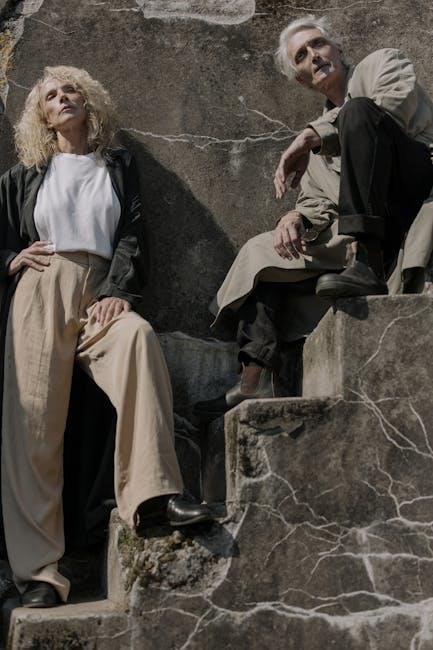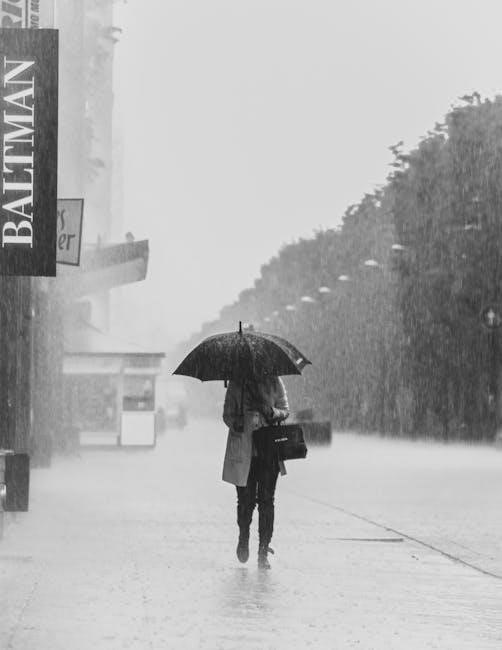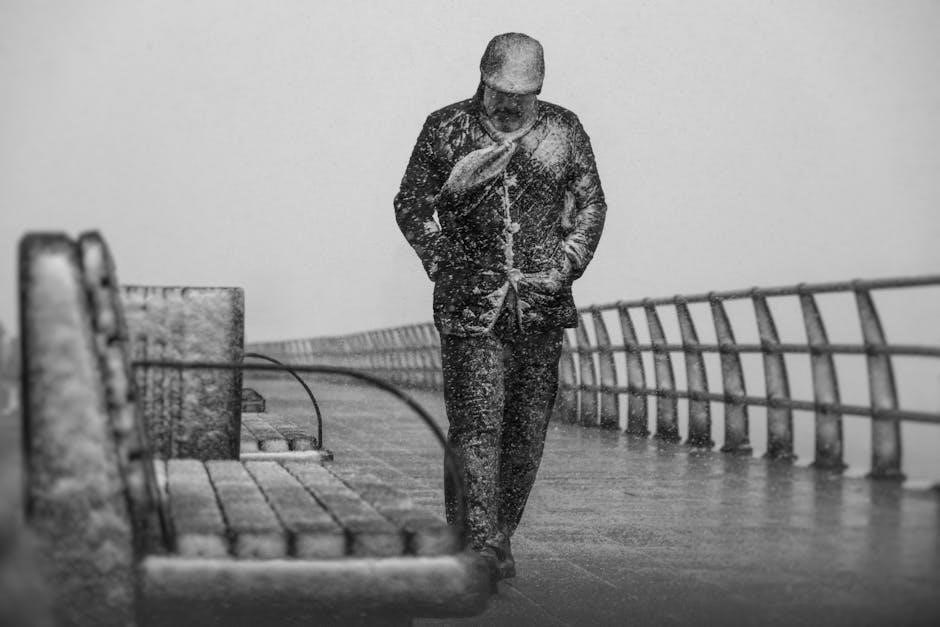The Overcoat PDF: An Overview
Nikolai Gogol’s “The Overcoat‚” published in 1842‚ is available in PDF format online․ This story follows Akaky Akakievich’s quest for a new overcoat‚ highlighting themes of poverty and social status in 19th-century Russia․
“The Overcoat‚” or “The Cloak‚” by Nikolai Gogol‚ is a poignant short story published in 1842 that delves into the life of Akaky Akakievich‚ a low-ranking government clerk in 19th-century Russia․ This narrative masterfully blends elements of realism and the grotesque‚ offering a satirical commentary on social hierarchy‚ the dehumanizing effects of bureaucracy‚ and the pursuit of material possessions․
The story centers around Akaky’s desperate need for a new overcoat to combat the harsh Russian winter․ His existing coat is tattered and ridiculed by his colleagues‚ symbolizing his insignificant social standing․ Gogol’s narrative explores the clerk’s painstaking efforts to save money for the overcoat‚ which becomes an object of immense value and personal fulfillment for him․
“The Overcoat” examines themes of social injustice‚ the plight of the common man‚ and the superficiality of societal values․ It has profoundly influenced Russian literature and continues to resonate with readers today․
Historical Context and Publication Year (1842)
Nikolai Gogol’s “The Overcoat” was published in 1842‚ a period of significant social and political change in Russia․ During this era‚ Russia was under the autocratic rule of Tsar Nicholas I‚ and the country’s bureaucratic system was expanding‚ leading to increased social stratification and a growing divide between the wealthy elite and the impoverished lower classes․ The story reflects the realities of life for ordinary people within this rigid structure․
The 1840s in Russia were also characterized by a burgeoning literary scene that explored themes of social injustice and the human condition․ Gogol’s work‚ including “The Overcoat‚” contributed to this trend by satirizing the bureaucracy and highlighting the struggles of marginalized individuals like Akaky Akakievich․
Published amidst these social and literary currents‚ “The Overcoat” offered a critical commentary on Russian society and the dehumanizing effects of its bureaucratic system․ The story resonated with readers by capturing the essence of everyday life for the common man and exposing the superficiality of societal values․ It solidified Gogol’s place as a major figure in Russian literature․

Character Analysis: Akaky Akakievich
Akaky Akakievich‚ the protagonist‚ is a low-ranking‚ impoverished clerk in 19th-century Russia․ He is portrayed as a meek and insignificant figure‚ whose life revolves around his work and‚ later‚ his overcoat․
Akaky’s Social Status and Poverty
Akaky Akakievich occupies a lowly position within the rigid social hierarchy of 19th-century Russia․ He is a government clerk‚ trapped in a monotonous routine of copying documents․ His income is meager‚ barely sufficient to cover his basic needs‚ highlighting the plight of the working class․
Akaky’s poverty is not just a financial state; it defines his existence․ He is invisible to society‚ overlooked and disregarded by his superiors and colleagues․ His worn-out overcoat serves as a constant reminder of his destitution and social insignificance․ The cold becomes a symbol of the harsh realities he faces daily․
His humble existence underscores the vast disparities in wealth and power prevalent in Russian society at the time․ Akaky’s story is a poignant commentary on the dehumanizing effects of poverty and the struggle for survival in a system that offers little opportunity for advancement or recognition․ He exemplifies the “little man” archetype․
Akaky’s Obsession with the Overcoat
Akaky’s obsession with the overcoat stems from his deep-seated feelings of inadequacy and insignificance․ His old coat‚ tattered and worn‚ symbolizes his degraded social status and constant exposure to the harsh realities of poverty․ The idea of a new overcoat consumes his thoughts․
The overcoat represents more than just warmth; it embodies acceptance‚ dignity‚ and a sense of belonging․ Akaky meticulously saves every penny‚ denying himself basic comforts to achieve his goal․ He becomes fixated on the tailor’s progress‚ eagerly anticipating the day he can finally possess the garment․
This obsession reveals Akaky’s vulnerability and his longing for something to improve his life․ The overcoat becomes a symbol of hope‚ a means to escape his dreary existence and gain recognition․ The acquisition of the overcoat is an attempt to find value and significance in a world that has consistently denied him both․

The Overcoat as a Symbol
In Gogol’s story‚ the overcoat transcends its literal function‚ representing status‚ acceptance‚ and Akaky’s aspirations for a better life․ Its loss signifies the crushing of his hopes and his ultimate demise․
The Overcoat’s Representation of Status and Acceptance
Within the rigid social hierarchy depicted in Nikolai Gogol’s “The Overcoat‚” the titular garment becomes a potent symbol of status and acceptance․ Akaky Akakievich‚ a lowly clerk‚ exists on the fringes of society‚ largely ignored and subjected to ridicule due to his threadbare coat․ The acquisition of a new overcoat‚ therefore‚ represents more than just protection from the harsh Russian winter; it embodies his yearning for recognition and inclusion․
The overcoat signifies a potential elevation in social standing‚ a chance to escape the anonymity and disrespect that have defined his existence․ For Akaky‚ owning a quality overcoat is akin to gaining entry into a more esteemed circle‚ where he might finally experience a sense of belonging and validation․ The garment becomes intertwined with his self-worth‚ representing his desire to be seen and acknowledged as a person of value within his bureaucratic world․
The Overcoat’s Loss and its Impact on Akaky
The theft of Akaky Akakievich’s cherished overcoat is the pivotal event that shatters his fragile sense of self and ultimately leads to his demise․ The overcoat‚ which had become a symbol of hope and a source of newfound confidence‚ is violently ripped away‚ leaving Akaky exposed and vulnerable‚ not only to the harsh winter but also to the indifference of society․
The loss is devastating because it strips him of his hard-earned status and throws him back into the abyss of anonymity․ Akaky’s identity had become inextricably linked to the overcoat‚ and without it‚ he is reduced to nothing in the eyes of the bureaucratic machine and the uncaring world․ The theft highlights the superficiality of the social acceptance he briefly experienced and underscores the profound emptiness of his existence․ The overcoat’s absence becomes a gaping hole in Akaky’s life‚ accelerating his decline and precipitating his tragic end․

Literary Significance and Influence
Gogol’s “The Overcoat” holds immense literary significance‚ profoundly influencing Russian literature․ Dostoevsky’s famous quote‚ “We all come out from Gogol’s Overcoat‚” encapsulates its impact on subsequent generations of writers and their works․
Dostoevsky’s Quote: “We all come out from Gogol’s Overcoat․”
Fyodor Dostoevsky’s celebrated quote‚ “We all come out from Gogol’s Overcoat‚” underscores the profound influence of Nikolai Gogol’s short story on the landscape of Russian literature․ This statement acknowledges “The Overcoat” as a foundational work‚ a springboard from which subsequent literary explorations of social injustice‚ human suffering‚ and the absurdity of bureaucratic life emerged․
The quote highlights Gogol’s pioneering portrayal of the “little man‚” exemplified by Akaky Akakievich‚ whose struggles resonated deeply with later writers․ Dostoevsky recognized that Gogol’s empathetic depiction of Akaky’s plight paved the way for a more nuanced and compassionate representation of marginalized characters in Russian literature․
“The Overcoat” served as a catalyst‚ inspiring writers to delve into the psychological complexities of ordinary individuals and to critique the dehumanizing effects of societal structures․ Dostoevsky’s quote stands as a testament to Gogol’s enduring legacy and his transformative impact on the course of Russian literary history․
Influence on Russian Literature
Nikolai Gogol’s “The Overcoat” exerted a considerable influence on the trajectory of Russian literature‚ particularly in its portrayal of the “little man” and its critique of social hierarchies․ Before Gogol‚ Russian literature often focused on aristocratic characters and grand historical narratives․ “The Overcoat” shifted this focus‚ bringing the struggles of ordinary individuals like Akaky Akakievich to the forefront․
This shift paved the way for later Russian authors to explore themes of poverty‚ alienation‚ and the dehumanizing effects of bureaucracy with greater depth and empathy․ Writers like Dostoevsky‚ Turgenev‚ and Chekhov were all influenced by Gogol’s innovative approach to character development and social commentary․
“The Overcoat” also contributed to the development of Russian realism‚ a literary movement that sought to depict life as it truly was‚ without romanticization or idealization․ By focusing on the mundane details of Akaky’s existence and the harsh realities of his social environment‚ Gogol helped to establish a new standard for authenticity in Russian literature‚ inspiring generations of writers to come․

Adaptations and Interpretations
Nikolai Gogol’s “The Overcoat” has seen numerous adaptations and interpretations across various media․ These include film and stage productions‚ reflecting the story’s enduring appeal and its capacity to resonate with diverse audiences․
Film Adaptations of “The Overcoat”
“The Overcoat” has inspired numerous film adaptations‚ showcasing the story’s timeless themes on the big screen․ These adaptations often reimagine Gogol’s tale in different contexts‚ sometimes modernizing the setting while retaining the core narrative․ Some adaptations closely follow the original plot‚ depicting Akaky’s struggles and the tragic loss of his coveted overcoat․
Other adaptations take creative liberties‚ offering unique interpretations of the story’s characters and themes․ These versions may emphasize different aspects of the narrative‚ such as the social commentary or the psychological impact of poverty․
Alberto Lattuada’s “The Overcoat” is a notable example‚ showcasing the story’s cinematic potential․ The availability of “The Overcoat” in PDF format allows viewers to compare the original text with its cinematic representations․
Stage Adaptations of “The Overcoat”
Nikolai Gogol’s “The Overcoat” has found a vibrant life on stage‚ with numerous adaptations bringing Akaky Akakievich’s story to theater audiences․ These stage productions often explore the story’s themes of social injustice‚ poverty‚ and the search for meaning in a bureaucratic world through dramatic interpretation․
The theatrical adaptations vary widely in their approach‚ ranging from faithful renditions of the original text to more experimental and avant-garde interpretations․ Some productions use physical theater‚ puppetry‚ or multimedia elements to enhance the storytelling and create a visually compelling experience․
The availability of “The Overcoat” in PDF format allows theater practitioners to closely examine Gogol’s language and structure‚ inspiring their creative choices in adapting the story for the stage․ These adaptations offer audiences a chance to connect with the story in a new and engaging way․
